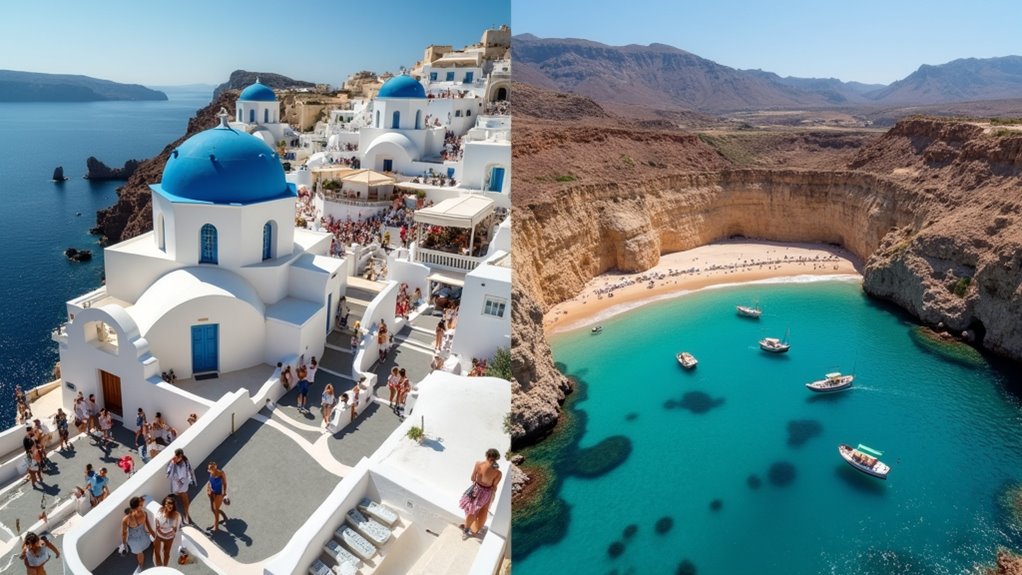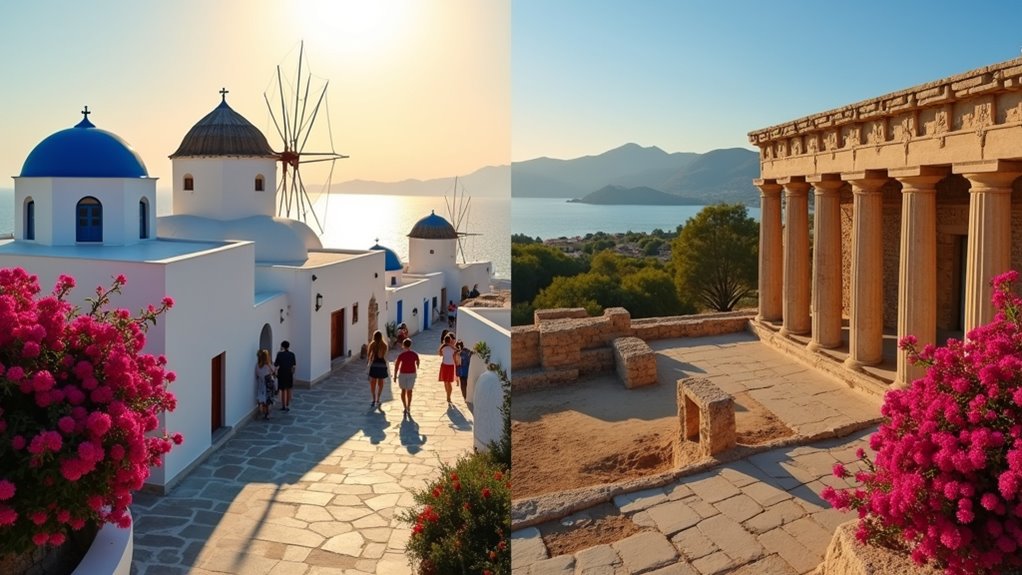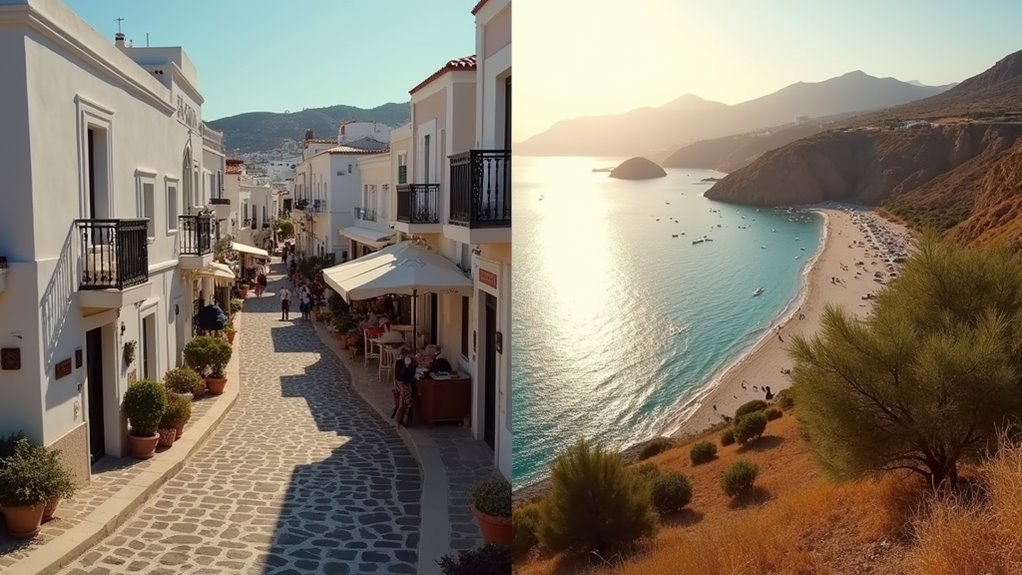Physical Address
304 North Cardinal St.
Dorchester Center, MA 02124
Physical Address
304 North Cardinal St.
Dorchester Center, MA 02124

Hanging between Mykonos' vibrant nightlife and Crete's ancient wonders, which Greek island paradise will capture your heart?
Imagine standing at a crossroads of crystal blue waters, with vibrant nightlife beckoning from one path and ancient history calling from the other. You’re facing the classic Greek island dilemma: Mykonos or Crete? Each island offers a distinctly different experience of Greece’s Mediterranean magic. If you’re torn between Mykonos’ glamorous party scene and Crete’s prosperous cultural tapestry, you’ll need to contemplate what truly matters for your perfect island getaway.

When considering the historical landscapes of Mykonos and Crete, you’ll find two dramatically different approaches to balancing ancient heritage with modern living.
Mykonos offers limited on-island ruins like the Neolithic Ftelia Settlement and Paleokastro Monastery, with most archaeological significance centered on nearby Delos Island. Delos holds immense historical importance as a UNESCO World Heritage site that was once the political and spiritual center of ancient Greece. Meanwhile, the island embraces luxury tourism, world-famous nightlife, and contemporary artistic expressions.
Crete showcases impressive Minoan complexes including Knossos Palace, Phaistos, and Malia, alongside Roman-era Gortyna and Venetian fortifications. While Athens features must-see sites that define mainland Greek history, Crete offers a distinctly different historical narrative through its Minoan civilization. Yet it maintains a year-round authentic lifestyle with agrotourism initiatives, diverse nightlife options, and multicultural urban landscapes.
While Mykonos strictly preserves its white Cycladic architecture amid tourism development, Crete manages multiple historical layers within its sustainable, community-centered approach to modern living.
The beaches of Mykonos and Crete reveal perhaps the most striking contrast between these popular Greek destinations. While Mykonos dazzles with lively shores like Paradise and Super Paradise Beach—known for vibrant parties and crowds—Crete offers remarkable diversity and natural wonders.
You’ll find Crete’s Elafonissi Beach with its pink sand and turquoise waters providing a more secluded experience. The island boasts unique landscapes like Vai’s palm forest and Preveli’s combination of river, palms, and sand.
Balos Lagoon enraptures with its exotic scenery and serene atmosphere despite its popularity. Mykonos beaches are perfect for travelers seeking a glamorous, party-oriented atmosphere during their Greek island getaway.
Mykonos excels in luxury and facilities, with Psarou Beach attracting celebrities and Santa Marina Resort offering high-end accommodations. Crete’s beaches, while sometimes having limited facilities, compensate with dramatic sunsets at Falassarna and natural preservation at its stunning lagoons. Families visiting Crete can find numerous family-friendly resorts with beachfront access and amenities designed specifically for children of all ages.

Nightlife in Mykonos and Crete represents perhaps their most dramatic difference for travelers seeking evening entertainment. Mykonos boasts a glamorous, high-energy scene with exclusive clubs like Tropicana and Super Paradise that stay open until dawn, attracting party-focused visitors and international DJs. While less well-known than Santorini’s islands, Mykonos and Crete offer distinct nightlife experiences worth exploring.
Crete offers a more authentic experience centered around cultural traditions. You’ll find laid-back bars in Chania and Malia, but the island truly shines with its traditional Greek music performances, folk dance events, and community festivals that celebrate local heritage.
Your preference depends entirely on your style: Mykonos draws younger crowds and singles looking for luxurious, vibrant party scenes (with 48.2% discovering it through influencers), while Crete provides family-friendly options and genuinely Greek cultural evenings. The island’s appeal is evident in visitor motivations with vibrant nightlife being the primary attraction for 32.9% of travelers choosing Mykonos.
Planning your Greek island getaway requires careful consideration of vastly different geographical scales between these two destinations. Crete, as Greece’s largest island (8,336 km²), demands 7-10 days for proper exploration of its extensive coastline and diverse regions.
Meanwhile, Mykonos (86 km²) can be thoroughly enjoyed in just 3-4 days.
Your access options differ markedly too. Crete offers three international airports and extensive road networks, while Mykonos has one airport and limited infrastructure. Among the Mediterranean’s 10,000 islands, these two represent contrasting travel experiences that require different planning approaches.
Ferry-wise, you’ll reach Mykonos from Athens in 2-5 hours versus Crete’s 6-9 hour journey.
For timing, both islands shine during April-May and September-October. However, Crete remains accessible year-round with stable pricing, while Mykonos experiences extreme summer congestion and price surges during peak season. If seeking a less crowded but equally beautiful alternative to Mykonos, Naxos island offers similar Cycladic charm with more relaxed atmosphere.

Understanding crowd patterns can dramatically shape your Greek island experience, with Mykonos and Crete offering distinctly different social atmospheres throughout the year.
Mykonos transforms from an intensely crowded summer hotspot to a quiet retreat in winter. During July and August, Mykonos feels particularly dense with over 1.5 million annual visitors plus 1.2 million cruise passengers concentrated on a small island.
Data shows Mykonos attracts significant interest from Italian travelers who represent 30% of visitors during the shoulder season, with notable search peaks in mid-September.
Unlike these islands, Athens maintains its allure year-round as a cultural destination with fewer extreme seasonal fluctuations in visitor numbers.
Both Mykonos and Crete showcase Greece’s culinary heritage through radically different dining experiences, reflecting each island’s unique character and visitor demographics.
Crete emphasizes hyper-local cuisine with rustic dishes like antikristo lamb and dakos barley rusk, often served in family-run tavernas with live Cretan music. You’ll find signature delicacies including snails in rosemary sauce and gamopilafo wedding pilaf, complemented by local tsikoudia spirit and indigenous wines. For those interested in mixing culinary adventures with body art, Crete also hosts several tattoo parlors where travelers can get inspired by ancient Minoan designs.
Mykonos balances traditional tavernas serving kopanisti cheese and louza sausage with high-end international options. In Mykonos town, travelers seeking authentic experiences can find traditional Greek tavernas like Marias and Nikos tucked away in quiet courtyards and side streets. The island boasts Michelin-starred restaurants, celebrity chefs, and beach clubs offering Japanese-Greek fusion and premium cocktails. Dining here often combines chic atmospheres with Aegean views, particularly at hotspots like Nammos where meals transform into DJ-accompanied experiences.
Whether you’re drawn to Mykonos’ Dionysian nightlife and glamorous beaches or Crete’s Minoan mysteries and authentic villages, you’ll find your ideal Greek experience. Mykonos delivers when you’re seeking vibrant energy and stylish escapades, while Crete rewards those yearning for cultural depth and diverse landscapes. Your perfect island awaits—just decide if you’re chasing Zeus’s thunderbolt of excitement or Athena’s wisdom of culture.